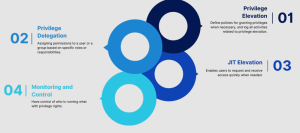What is Privilege Elevation and Delegation Management (PEDM)?
Did you know that privilege escalation is one of the most common tactics cybercriminals use to gain unauthorized access to sensitive systems? Indeed, for many organizations, managing elevated privileges remains a serious challenge, leaving them highly vulnerable to both internal and external threats. Privilege Elevation and Delegation Management solves this very problem by providing fine-grained, just-in-time control over user privileges, thus letting an organization protect its critical assets with confidence.
Understanding the basics of Privilege Elevation and Delegation Management
PEDM offers a more precise and flexible alternative to traditional security measures. By enabling granular control at the process level, PEDM ensures that users can perform only the tasks they are authorized for, under specific conditions, and at designated times. This fine-grained control not only enhances security but also maintains operational efficiency by aligning permissions with actual business needs. Concretely, PEDM empowers organizations to define “who can do what, when, and under what circumstances,” reducing risks while supporting seamless workflows.
Business benefits of implementing PEDM in your organization
The implementation of PEDM delivers significant benefits, including a dramatically reduced attack surface achieved through precise privilege management and the elimination of standing administrator accounts. It enhances compliance with regulatory frameworks by providing comprehensive audit trails and robust access monitoring. Control improvements are visible immediately upon deployment, thanks to the ability to manage security policies from a centralized console. Additionally, PEDM offers seamless scalability, leveraging a modern client-server architecture tailored for enterprise environments.
What are the key features of a thorough PEDM solution?
A PEDM solution should incorporate key features such as privilege elevation, allowing organizations to define policies for granting privileges as needed while maintaining detailed logs of all related activities. It should enable privilege delegation, assigning permissions based on specific roles or responsibilities, and just-in-time (JIT) elevation, which allows users to request and receive necessary access quickly and efficiently. Additionally, robust monitoring and control are crucial for overseeing who is using privilege rights, ensuring transparency and security without impacting operational performance.

Why do organizations need it?
Modern IT environments are riddled with challenges such as excess access rights, misused privileges, and standing administrator accounts, which introduce the most significant vulnerabilities. The increasing regulatory scrutiny combined with these risks raises the demand for a more focused approach to managing privileges at a granular level. PEDM provides targeted solutions to organizations in order to tackle these challenges and reduce the risk without compromising operational efficiency. It is complementary to the broader security strategies, addressing privilege management needs that the traditional solutions do not fully address, hence enabling organizations to strengthen their defenses without unnecessary disruption.
Practical Use Cases for PEDM
PEDM proves indispensable across a range of scenarios, including:
- IT maintenance operations requiring temporary elevated privileges
- Application troubleshooting without granting full administrative rights
- Software installation and updates with minimal security exposure
- Developer environments necessitating specific elevated permissions
How PEDM Works
PEDM works by granting privileges to a specific application and process level, rather than to an account. If a user needs to execute a privileged activity, the system temporarily elevates the permissions for that process but keeps all other operations secure.
Principle of Least Privilege in PEDM
The implementation of PEDM is deeply aligned with the Principle of Least Privilege (PoLP), which operates on a “Need-To-Know Basis” to limit access to only what is essential for users to perform their duties. This approach helps organizations mitigate risks by controlling access to resources—such as blocking unnecessary connections initiated by specific applications—and supervising application behavior in real time, including their interactions with disks, networks, and other system components. By limiting permissions and actively overseeing activities, PEDM minimizes security risks while preserving a seamless balance between strong protection and uninterrupted user productivity.
On the Road to Zero Trust with PEDM
PEDM aligns perfectly with zero-trust security principles by:
- Verifying every access request regardless of source
- Implementing continuous authentication and authorization
- Providing granular control over resource access
- Maintaining detailed audit trails of all privileged activities
How Does PEDM Complement Traditional Privileged Access Management?
Traditional Privileged Access Management (PAM) and Privilege Elevation and Delegation Management (PEDM) address different aspects of privilege management but work together to create a robust security framework:
Key Differences Between PAM and PEDM:
- PAM: Focuses on securing privileged accounts and managing access to critical systems through account-level controls and session monitoring.
- PEDM: Operates at the process level, enabling precise privilege elevation for specific tasks without requiring full administrator access.
How PAM and PEDM Complement Each Other:
- Enhanced Security: PAM governs who can access privileged accounts, while PEDM ensures those accounts are used with the least privilege necessary, reducing the risk of over-permissioned access.
- Reduced Attack Surface: PEDM minimizes the reliance on standing administrator accounts, decreasing the number of high-risk privileged accounts in the environment.
- Granular Control: PEDM provides fine-grained, task-specific privilege elevation, complementing PAM’s broader account-level controls.
- Improved Compliance: PAM ensures accountability through session recording and auditing, while PEDM supports compliance with granular access logs and least-privilege enforcement.
Conclusion
Privilege Elevation and Delegation Management (PEDM) equips organizations with the tools they need to implement truly granular access control without sacrificing operational efficiency. By eliminating the need to stand administrator accounts and providing precise, process-level security controls, PEDM helps organizations achieve enhanced security with improved productivity.
Consider exploring WALLIX PEDM to strengthen your organization’s security posture and embrace a zero-trust future with confidence.

